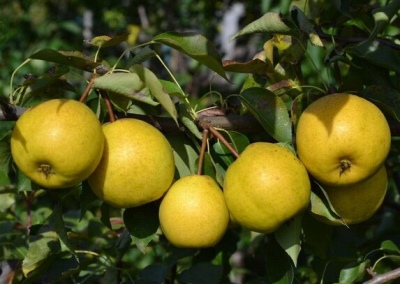
- Authors: Kotov L. A., Tikhonova A. S. (FGBNU "Ural Federal Agrarian Research Center of the Ural Branch of the Russian Academy of Sciences"
- Appeared when crossing: seedling of the Ussuri pear x Bere Bosk, mutagenesis
- Name synonyms: Bere yellow improved
- Year of approval: 2002
- Fruit weight, g: 90
- Ripening terms: autumn
- Fruit picking time: from September 20 to October 1
- Appointment: table, dessert
- Growth type: medium height
- Yield: high
It is difficult to grow fruit trees in the regions of the Urals and Siberia. The harsh climatic conditions are to blame for all this. However, Russian scientists are developing hybrids that can withstand even the most severe frost and please with fruits in a short summer time. These include the Berezhenaya pear.
Breeding history
The culture was created by domestic breeders L.A. Kotov and A.S. Tikhonova on the basis of the Ural Federal Agrarian Research Center of the Russian Academy of Sciences. It has been approved for use since 2002.
The culture was obtained as a result of crossing the variety Bere Bosk and the seedling of the Ussuri pear, later artificial mutagenesis was carried out. Synonym for the name - Bere yellow improved.
Description of the variety
The cherished pear has a table and dessert purpose. The tree is medium-sized, compact, grows more than 3 m in height. The crown is oval and thin. Curved shoots are predominantly straight, can be slightly arcuate or rounded, colored brown.
The twigs grow upward at a fairly wide angle. Leaves are many, medium in size, ovoid, their color is light green. Blooms profusely. The flowers are white and small.
Fruit characteristics
The fruit is generally rounded pear-shaped. They are not large, the weight of one fruit can be 90 grams. During the period of removable ripeness, their color is light yellow, without blush. The skin is dry and tender, with a barely noticeable number of small subcutaneous spots. The harvested crop retains its nutrients for a long time. Keeping quality is good, about two and a half months.
Taste qualities
Pear has a harmonious sweet and sour taste, with a pleasant fruity aroma. Tasting score 4.2 points out of 5. The pulp is juicy, without granulation, buttery. Her color is cream. Chemical composition, balanced in content: sugars - 10.5%; acids - 1.0%; soluble solids - 12.4%.
Initially, a slight astringency may be present in the taste, which is lost with a week of aging, while acquiring a richer sweet taste.
Ripening and fruiting
The variety belongs to the autumn category. The culture begins to delight with the first fruits at 3-4 years of development. From October to December, the pear gains the necessary consumer ripeness of the fruit. The ripe crop is not crumbled. Subsequent collection is possible until the onset of frost. Fruiting is regular, without interruption.

Yield
The tree has an average yield. 139 centners are harvested from 1 hectare.
Growing regions
The culture is doing well in the regions of the Urals, the Cis-Urals and Volgo-Vyatka. In warmer climatic conditions, it is not recommended to cultivate the variety, the level of fruiting decreases.
Self-fertility and the need for pollinators
The hybrid is self-fertile. Therefore, he needs cross-pollination with other plants. For this, pollinating varieties such as Prosto Maria, Pamyati Yakovleva, Svarog, Osennyaya Yakovleva, Pamyati Zhegalov, Perun are best suited.
Landing
Between young seedlings, it is necessary to leave a free space of 3-4 meters. A distance of 4-5 meters is also maintained between individual rows. It is preferable to plant in a sunny place, with a slight rise.


Growing and caring
It is better to plant seedlings in the spring, so that they take root and grow stronger during the summer. The landing pit is prepared in advance. The depth should be about 1 meter. At the bottom, a drainage layer is first laid, then a fertile mixture consisting of compost, humus and peat comes. The roots of the Berezhenaya are gently straightened and covered with earth. The soil is tamped a little and watered abundantly.
To get a good harvest every year, the pear should be fed with organic and mineral fertilizers. In the springtime, seedlings need nitrogen to build up their green mass. During flowering and fruit formation - phosphorus and potassium. However, one should be careful with the amount of mineral nutrition applied. Excess nitrogen leads to burns on the leaves, and a large amount of nitrates accumulates in the fruits.
In spring and autumn, the plant needs pruning. Old, broken branches with signs of disease are removed. Watering is required in moderation, as the soil dries up. It will be useful to carry out mulching, which protects not only from drying out of the soil, but also serves as an additional source of food.



Disease and pest resistance
Differs in good persistent immunity to most infectious diseases and pests, especially to scab and pear gall mite. To prevent the development of infection in the spring before flowering, spraying with special preparations is carried out.

Like any other fruit trees, the pear needs protection from various diseases and pests. When planting a pear on your site, you need to know in advance what diseases you should beware of. To successfully carry out the struggle, it is necessary first to correctly identify the cause of the problem. It is important to distinguish signs of disease from manifestations of the presence of insects, mites, caterpillars and other types of pests.
Resistance to soil and climatic conditions
The pear feels great in the harsh conditions of the Siberian climate. This variety can easily endure the most severe frosts down to -45 ... 50 degrees. But heat and drought can destroy a tree.





































































